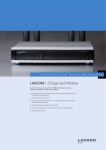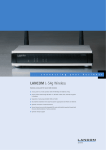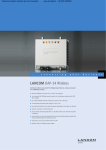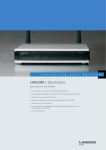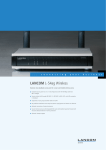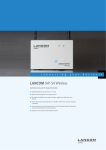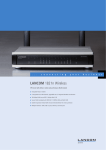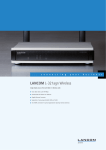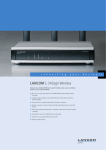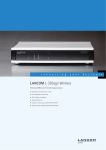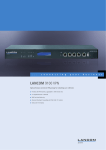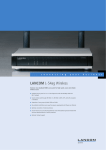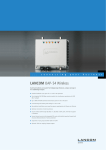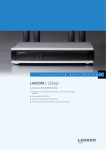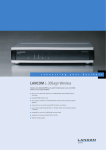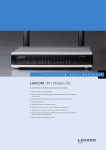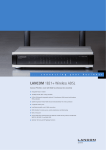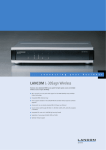Download LANCOM L-315agn dual Wireless
Transcript
Telecomunicazioni semplici per il tuo business . . . www.devitalia.it +39 050-7846000 [email protected] c o n n e c t i n g y o u r LANCOM L-315agn dual Wireless Dual- radio dual- band access point with MIMO technology for enormous flexibility, redundancy and high data- throughput 쮿 Two integrated radio modules (1x 802.11abgn, 1x 802.11abg) for simultaneous 2.4- and 5 GHz wireless network operations 쮿 Power supply via IEEE 802.3af PoE 쮿 Operates as a stand-alone access point or as a managed access point in combination with LANCOM WLAN controllers 쮿 Separation of user groups by Multi- SSID and VLAN 쮿 Four external antennas, plus an additional internal antenna for MIMO operation 쮿 Optional: Hotspot support b u s i n e s s Telecomunicazioni semplici per il tuo business www.devitalia.it +39 050-7846000 [email protected] The business access point LANCOM L- 315agn dual Wireless features two integrated dual- band radio modules for maximum flexibility. One module works with the 802.11n (draft 2.0) standard and offers greatly improved range and throughput from MIMO technology. Connectivity is optimized as the WLAN standards in the 2.4- and 5- GHz frequency bands can be operated in parallel. With support for both wireless frequency bands, migration from the 2.4 to 5 GHz can be gradual and thus economic–or both standards can be operated in parallel. Other applications range from the build- up of wireless distribution structures to the establishment of infrastructure networks with operational redundancy. Even with both radio modules operating simultaneously, power can be supplied by IEEE 802.3af- compliant PoE switches or Power Injectors. More Performance The 802.11n draft 2.0 standard includes many new mechanisms–such as MIMO, the use of 40- MHz channels, packet aggregation and block acknowledgement–for significant increases in the available bandwidth. This provides more than five times the speed of 802.11a/g networks with physical data rates of up to 300 Mbps. Better and Reliable Coverage. MIMO technology (Multiple Input Multiple Output) employed by the LANCOM L- 315agn dual Wireless enables multiple antennas to be operated at the transmitter and receiver, thus supporting multiple spatially separate data streams. Multiple data streams travel by different paths and, apart from increasing the overall system throughput and signal coverage, they also reduce the occurrence of dead zones in wireless networks. This results in higher data rates and improved stability for significantly better wireless network utilization, in particular for users in professional environments. More Security. The LANCOM L- 315agn dual Wireless sets standards in security. Along with operational reliability from redundant power supplies and high availability from its two WLAN interfaces, there is full support of the complete range of security standards required for professional WLAN operations. The range of security standards includes WPA/802.11i, authentication mechanisms such as 802.1x/EAP, Multi- SSID applications with dynamic VLAN assignment–and it doesn't stop there. Other security mechanisms include integrated background scanning for rogue AP detection. More Management. LANCOM’s WLAN Management Tools offer real benefits to network administrators for the installation, control and monitoring of access points. What's more, the LANCOM L- 315agn dual Wireless is directly supported by LANCOM WLAN controllers without requiring any software upgrades. This "smart controller" technology from LANCOM has been developed specifically to support high bandwidths, and it offers flexible breakout for payload data. This enables, for example, data from high- bandwidth applications to break- out directly from the access point to the LAN, so saving you the costs of upgrading your central network architecture. The WLANmonitor software (supplied) provides a complete overview of all WLAN networks and clients within range. More Reliability for the Future. From the earliest days, LANCOM products have been designed for a product life of several years. They are equipped with hardware which is dimensioned for the future. Even reaching back to older product generations, updates to the LANCOM Operating System–LCOS–are available several times a year, free of charge and offering major features. LANCOM offers unbeatable protection of your investment! Telecomunicazioni semplici per il tuo business www.devitalia.it +39 050-7846000 [email protected] LANCOM L-315agn dual Wireless Scope of features: as of LCOS version 7.6x WLAN Frequency band 2.4 GHz and 5 GHz 2400 - 2483.5 MHz (ISM) and 5150- 5825 MHz (depending on country- specific restrictions) Data rates 2.4 GHz Module 1: 54 Mbps to IEEE 802.11g (fallback to 48, 36 , 24, 18, 12, 9, 6 Mbps, Automatic Rate Selection) compatible to IEEE 802.11b (11, 5.5, 2, 1 Mbps, Automatic Rate Selection), 802.11 b/g compatibility mode or pure g or pure b, Super A/G with Turbo Mode (108 Mbps), bursting, compression Module 2: 54 Mbps to IEEE 802.11g (fallback to 48, 36 , 24, 18, 12, 9, 6 Mbps, Automatic Rate Selection) compatible to IEEE 802.11b (11, 5.5, 2, 1 Mbps, Automatic Rate Selection), 802.11 b/g compatibility mode or pure g or pure b Data rates 5 GHz Module 1: 54 Mbps to IEEE 802.11a/h (fallback to 48, 36 , 24, 18, 12, 9, 6 Mbps, Automatic Rate Selection), Super A/G with Turbo Mode (108 Mbps), bursting, compression, fully compatible with TPC (adjustable power output) and DFS (automatic channel selection, radar detection) according to ETSI regulations. Module 2: 54 Mbps (fallback to 48, 36 , 24, 18, 12, 9, 6 Mbps, Automatic Rate Selection), fully compatible with TPC (adjustable power output) and DFS 2 (automatic channel selection, radar detection) according to ETSI regulations. Data rates 802.11n Module 2: 300 Mbps according to IEEE 802.11n Draft 2.0 with MSC15 (Fallback to 6,5 Mbps with MSC0) Range 802.11a/b/g * Up to 150 m (up to 30 m in buildings) * Range 802.11n Up to 250 m @ 6.5 Mbps (up to 20 m @ 300 Mbps indoor)* Output power at antenna connector, 2.4 GHz Module 1: 802.11b: +19 dBm @ 1 and 2 Mbps, +19 dBm @ 5.5 and 11 Mbps; 802.11g: +19 dBm @ 6 Mbps, +14 dBm @ 54 Mbps Module 2: 802.11g: +18 dBm @ 6 to 36 Mbps, +17 dBm @ 48 Mbps, +16 dBm @ 54 Mbps; 802.11n: +19 dBm @ 6,5/13 Mbps (MCS0/8, 20 MHz), +10 dBm @ 65/130 Mbps (MCS7/15, 20 MHz), +17 dBm @ 15/30 Mbps (MCS0/8, 40 MHz), +10 dBm @ 150/300 Mbps (MCS7/15, 40 MHz) Output power at antenna connector, 5 GHz Module 1: 802.11a/h: +18 dBm @ 6 Mbps, +12 dBm @ 54 Mbps Module 2: 802.11a/h: +18 dBm @ 6 to 24 Mbps, +17 dBm @ 36 Mbps, +16 dBm @ 48 Mbps, +15 dBm @ 54 Mbps; 802.11n: +18 dBm @ 6,5/13 Mbps (MCS0/8, 20 MHz), +10 dBm @ 65/130 Mbps (MCS7/15, 20 MHz), +17 dBm @ 15/30 Mbps (MCS0/8, 40 MHz), +10 dBm @ 150/300 Mbps (MCS7/15, 40 MHz) Max. radiated power (EIRP), 2.4 GHz band 802.11b/g: Up to 20 dBm / 100 mW EIRP (transmission power control according to TPC or manual settings) Max. radiated power (EIRP), 5 GHz band 802.11a/h: Up to 30 dBm / 1000 mW or up to 36 dBm / 4000 mW EIRP (depending on national regulation on channel usage and subject to further obligations such as TPC and DFS) Minimum transmission power Transmission power reduction in software in 1 dB steps to min. 0.5 dBm Reception sensitivity 2.4 GHz Module 1: 802.11b: - 86 dBm @ 11 MBit/s, - 94 dBm @ 1 MBit/s; 802.11g: - 68 dBm @ 54 MBit/s, - 87 dBm @ 6 MBit/s Module 2: 802.11b: - 87 dBm @ 11 MBit/s, - 92 dBm @ 1 MBit/s; 802.11g: - 79 dBm @ 54 MBit/s, - 92 dBm @ 6 MBit/s; 802.11n (20MHz): - 71 dBm @ 150 MBit/s, - 91 dBm @ 15 MBit/s; 802.11n (40MHz): - 67 dBm @ 300 MBit/s, - 86 dBm @ 30 MBit/s Reception sensitivity 5 GHz Module 1: 802.11a/h: - 67 dBm @ 54 MBit/s; - 87 dBm @ 6 MBit/s Module 2: 802.11a/h: - 78 dBm @ 54 MBit/s; - 91 dBm @ 6 MBit/s; 802.11n (20MHz): - 69 dBm @ 150 MBit/s, - 90 dBm @ 15 MBit/s; 802.11n (40MHz): - 66 dBm @ 300 MBit/s, - 87 dBm @ 30 MBit/s Radio channels 2.4 GHz Up to 13 channels, max. 3 non- overlapping (2.4 GHz band) Radio channels 5 GHz Up to 26 non- overlapping channels (available channels and further obligations such as automatic DFS2 dynamic channel selection depending on national regulation) Roaming Seamless handover between radio cells, IAPP support, IEEE 802.11d support WPA2 fast roaming Pre- authentication and PMK caching for fast roaming Fast client roaming With background scanning, moving LANCOM "client mode" access points pre- authenticate to alternative access points which offer a better signal before Roaming fails VLAN VLAN ID definable per interface, WLAN SSID, point- to- point connection and routing context (4094 IDs) Dynamic VLAN assignment Dynamic VLAN assignment for target user groups based on MAC addresses, BSSID or SSID by means of external RADIUS server. Q- in- Q tagging Support of layered 802.1q VLANs (double tagging) Multi- SSID Simultaneous use of up to 8 independent WLAN networks per WLAN interface Security IEEE 802.11i / WPA2 with passphrase or 802.1x and hardware- accelerated AES, closed network, WEP64, WEP128, WEP152, user authentication, 802.1x /EAP, LEPS, WPA1/TKIP RADIUS server Integrated RADIUS server for MAC address list management EAP server Integrated EAP server for authentication of 802.1x clients via EAP- TLS, EAP- TTLS, PEAP, MSCHAP or MSCHAPv2 Quality of Service Prioritization according to Wireless Multimedia Extensions (WME, subset of IEEE 802.11e) Bandwidth limitation Each WLAN client (MAC address) can be assigned maximum transmit and receive rates and an individual VLAN ID Telecomunicazioni semplici per il tuo business www.devitalia.it +39 050-7846000 [email protected] LANCOM L-315agn dual Wireless Scope of features: as of LCOS version 7.6x WLAN Background scanning Detection of rogue AP's and the channel information for all WLAN channels during normal AP operation. The Background Scan Time Interval defines the time slots in which an AP or Router searches for a foreign WLAN network in its vicinity. The time interval can be specified in either milliseconds, seconds, minutes, hours or days. Client detection Rogue WLAN client detection based on probe requests 802.1x supplicant Authentication of an access point in WLAN client mode at another access point via 802.1X (EAP- TLS, EAP- TTLS and PEAP) *) Note The effective distances and transmission rates that can be achieved are depending of the site RF conditions. 802.11n Draft 2.0 Features MIMO MIMO technology is a technique which uses multiple transmitters to deliver multiple data streams via different spatial channels. LANCOM uses a 3 x 3 MIMO Configuration where 2 data streams are spread over 3 transmitters. Depending on the existing RF conditions the throughput is doubled with MIMO technology 40 MHz Channels Two adjacent 20 MHz channels are combined to create a single 40 MHz channel. Depending on the existing RF Conditions channel bonding doubles the throughput. MAC Aggregation and Block Acknowledgement MAC Aggregation increase the 802.11 MAC efficiency by combining MAC data frames and sending it out with a single header. The receiver acknowledges the combined MAC frame with a Block Acknowledgement. Depending on existing RF conditions, this technique improves throughput by up to 20%. Short Guard Interval The guard interval is the time between OFDM symbols in the air. 802.11n gives the option for a shorter 400 nsec guard interval compared to the legacy 800 nsec guard interval. Under ideal RF conditions this increases the throughput by upto 10% WLAN operating modes WLAN access point Infrastructure mode (autonomous operation or managed by LANCOM WLAN Controller) WLAN bridge Point- to- multipoint connection of up to 7 Ethernet LANs (mixed operation optional), broken link detection, blind mode, up to 32 VLANs simultaneously for WLAN connections. When configuring Pt- to- Pt links, pre- configured names can be used as an alternative to MAC Adresses for creating a link. WLAN router Use of the LAN connector for simultaneous DSL over LAN, IP router, NAT/Reverse NAT (IP masquerading) DHCP server, DHCP client, DHCP relay server, DNS server, PPPoE client (incl.Multi- PPPoE), PPTP client and server, NetBIOS proxy, DynDNS client, NTP, port mapping, policy- based routing based on routing tags, tagging based on firewall rules, dynamic routing with RIPv2, VRRP, rapid spanning- tree protocol to support redundant routes in Ethernet networks WLAN client Transparent WLAN client mode for wireless Ethernet extensions, e.g. connecting PCs or printers by Ethernet; up to 64 MAC addresses Firewall Stateful inspection firewall Incoming/Outgoing Traffic inspection based on connection information. Trigger for firewall rules depending on backup status, e.g. simplified rule sets for low- bandwidth backup lines. Limitation of the number of session per remote site (ID) Packet filter Check based on the header information of an IP packet (IP or MAC source/destination addresses; source/destination ports, DiffServ attribute); remote- site dependant, direction dependant, bandwidth dependant Extended port forwarding Network Address Translation (NAT) based on protocol and WAN address, i.e. to make internal webservers accessible from WAN N:N IP address mapping N:N IP address mapping for translation of IP addresses or entire networks Tagging The firewall marks packets with routing tags, e.g. for policy- based routing Actions Forward, drop, reject, block sender address, close destination port, disconnect Notification Via e- mail, SYSLOG or SNMP trap Quality of Service Traffic shaping Dynamic bandwidth management with IP traffic shaping Bandwidth reservation Dynamic reservation of minimum and maximum bandwidths, totally or connection based, separate settings for send and receive directions. Setting relative bandwidth limits for QoS in percent DiffServ/TOS Priority queuing of packets based on DiffServ/TOS fields Packet- size control Automatic packet- size control by fragmentation or Path Maximum Transmission Unit (PMTU) adjustment. Layer 2/Layer 3 tagging Automatic or fixed translation of layer- 2 priority information (802.11p- marked Ethernet frames) to layer- 3 DiffServ attributes in routing mode. Translation from layer 3 to layer 2 with automatic recognition of 802.1p- support in the destination device. Security Intrusion Prevention Monitoring and blocking of login attempts and port scans IP spoofing Source IP address check on all interfaces: only IP addresses belonging to the defined IP networks are allowed Access control lists Filtering of IP or MAC addresses and preset protocols for configuration access Denial of Service protection Protection from fragmentation errors and SYN flooding General Detailed settings for handling reassembly, PING, stealth mode and AUTH port URL blocker Filtering of unwanted URLs based on DNS hitlists and wildcard filters Password protection Password- protected configuration access can be set for each interface Telecomunicazioni semplici per il tuo business www.devitalia.it +39 050-7846000 [email protected] LANCOM L-315agn dual Wireless Scope of features: as of LCOS version 7.6x Security Alerts Alerts via e- mail, SNMP- Traps and SYSLOG Authentication mechanisms EAP- TLS, EAP- TTLS, PEAP, MS- CHAP, MS- CHAPv2 as EAP authentication mechanisms, PAP, CHAP, MS- CHAP and MS- CHAPv2 as PPP authentication mechanisms WLAN protocol filters Limitation of the allowed transfer protocols, source and target addresses on the WLAN interface Adjustable reset button Adjustable reset button for "ignore", "boot- only" and "reset- or- boot" IP redirect Fixed redirection of any packet received over the WLAN interface to a dedicated target address High availability / redundancy VRRP VRRP (Virtual Router Redundancy Protocol) for backup in case of failure of a device or remote station. Enables passive standby groups or reciprocal backup between multiple active devices including load balancing and user definable backup priorities FirmSafe For completely safe software upgrades thanks to two stored firmware versions, incl. test mode for firmware updates Analog/GSM modem backup Optional operation of an analog or GSM modem at the serial interface Line monitoring Line monitoring with LCP echo monitoring, up to 4 addresses for end- to- end monitoring with ICMP polling. Routing functions Router IP and NetBIOS/IP multi- protocol router Advanced Routing and Forwarding Separate processing of 8 contexts due to virtualization of the routers. Mapping to VLANs and complete independent management and configuration of IP networks in the device, i.e. individual settings for DHCP, DNS, Firewalling, QoS, VLAN, Routing etc. Automatic learning of routing tags for ARF contexts from the routing table HTTP HTTP and HTTPS server for configuration by web interface DNS DNS client, DNS server, DNS relay, DNS proxy and dynamic DNS client DHCP DHCP client, DHCP relay and DHCP server with autodetection NetBIOS NetBIOS/IP proxy NTP NTP client and SNTP server, automatic adjustment for daylight- saving time Policy- based routing Policy- based routing based on routing tags. Based on firewall rules, certain data types are marked for specific routing, e.g. to particular remote sites or lines. Dynamic routing Dynamic routing with RIPv2. Learning and propagating routes; separate settings for LAN and WAN. Extended RIPv2 including HopCount, Poisoned Reverse, Triggered Update for LAN (acc. to RFC 2453) and WAN (acc. to RFC 2091) as well as filter options for propagation of routes. Definition of RIP sources with wildcards COM port server COM port forwarding COM- port server for the DIN interface. For a serial device connected to it, the server manages its own virtual COM port via Telnet (RFC 2217) for remote maintenance (works with popular virtual COM- port drivers compliant with RFC 2217) LAN protocols IP ARP, proxy ARP, BOOTP, DHCP, DNS, HTTP, HTTPS, IP, ICMP, NTP/SNTP, NetBIOS, PPPoE (server), RADIUS, RIP- 1, RIP- 2, RTP, SIP, SNMP, TCP, TFTP, UDP, VRRP, VLAN Rapid Spanning Tree 802.1d Spanning Tree and 802.1w Rapid Spanning Tree support for dynamic path selection with redundant layer 2 connections WAN protocols Ethernet PPPoE, Multi- PPPoE, ML- PPP, PPTP (PAC or PNS) and plain Ethernet (with or without DHCP), RIP- 1, RIP- 2, VLAN, IP Interfaces 1st LAN port 10/100Base- TX, autosensing, auto node hub, PoE compliant with IEEE 802.3af 2nd LAN port 10/100Base- TX, autosensing, auto node hub, PoE compliant with IEEE 802.3af DSL over LAN (DSLoL) The LAN port can (even parallel to LAN mode) be used as a WAN port for connecting external DSL modems (PPPoE) or external routers. Serial interface Serial configuration interface / COM port (8 pin Mini- DIN): 9,600 - 115,000 baud, suitable for optional connection of analog/ GPRS modems External antenna connectors Four reverse SMA connectors for external LANCOM AirLancer Extender antennas or for antennas from other vendors. One additional internal antenna for 802.11n MIMO operation. Please respect the restrictions which apply in your country when setting up an antenna system. For information about calculating the correct antenna setup, please refer to www.lancomsystems.com. Telecomunicazioni semplici per il tuo business www.devitalia.it +39 050-7846000 [email protected] LANCOM L-315agn dual Wireless Scope of features: as of LCOS version 7.6x Management LANconfig Configuration program for Microsoft Windows, incl. convenient Setup Wizards. Optional group configuration, simultaneous remote configuration and management of multiple devices over IP connection (HTTPS, HTTP, TFTP). Configuration program properties per project or user. Automatic storage of the current configuration before firmware updates. Exchange of configuration files between similar devices, e.g. for migrating existing configurations to new LANCOM products. Detection and display of the LANCOM managed switches LANmonitor Monitoring application for Microsoft Windows for (remote) surveillance and logging of the status of LANCOM devices and connections, incl. PING diagnosis and TRACE with filters and save to file. Search function within TRACE tasks. Wizards for standard diagnostics. Export of diagnostic files for support purposes (including bootlog, sysinfo and device configuration without passwords). Monitoring of the LANCOM managed switches WLANmonitor Monitoring application for Microsoft Windows for the visualization and monitoring of LANCOM WLAN installations, incl. Rogue AP and Rogue Client visualization Firwall GUI Graphical user interface for configuring the object- oriented firewall in LANconfig: Tabular presentation with symbols for rapid understanding of objects, choice of symbols for objects, objects for actions/Quality of Service/remote sites/services, default objects for common scenarios, individual object definition (e.g. for user groups) WEBconfig Integrated web server for the configuration of LANCOM devices via Internet browsers with HTTPS or HTTP. Similar to LANconfig with a system overview, syslog and events display, symbols in the menu tree, quick access with side tabs. WEBconfig also features Wizards for basic configuration, security, Internet access, LAN- LAN coupling. Online help for parameters in LCOS menu tree Device Syslog Syslog buffer in the RAM (size depending on device memory) to store events for diagnosis. Default set of rules for the event protocol in Syslog. The rules can be modified by the administrator. Display and saving of internal Syslog buffer (events) from LANCOM devices with LANmonitor, display only with WEBconfig Access rights Individual access and function rights for up to 16 administrators User administration RADIUS user administration for dial- in access (PPP/PPTP). Support for RADSEC (Secure RADIUS) providing secure communication with RADIUS servers Remote maintenance Remote configuration with Telnet/SSL, SSH (with password or public key), browser (HTTP/HTTPS), TFTP or SNMP, firmware upload via HTTP/HTTPS or TFTP Remote maintenance of 3rd party devices A remote configuration for devices behind der LANCOM can be accomplished (after authentication) via tunneling of arbitrary TCP- based protocols, e.g. for HTTP(S) remote maintenance of VoIP phones or printers of the LAN TFTP & HTTP(S) client For downloading firmware and configuration files from an TFTP, HTTP or HTTPS server with variable file names (wildcards for name, MAC/IP address, serial number), e.g. for roll- out management. Commands for live Telnet session, scripts or CRON jobs Security Access rights (read/write) over WAN or (W)LAN can be set up separately (Telnet/SSL, SSH, SNMP, HTTPS/HTTP), access control list Scripting Scripting function for batch- programming of all command- line parameters and for transferring (partial) configurations, irrespective of software versions and device types, incl. test mode for parameter changes SNMP SNMP management via SNMP V2, private MIB exportable by WEBconfig, MIB II Timed control Scheduled control of parameters and actions with CRON service Diagnosis Extensive LOG and TRACE options, PING and TRACEROUTE for checking connections, LANmonitor status display, internal logging buffer for SYSLOG and firewall events LANCOM WLAN Controller Supported by all LANCOM WLAN Controller (separate optional hardware equipment for installation, optimization, operating and monitoring of WLAN networks, except for P2P connections) Statistics Statistics Extensive Ethernet, IP and DNS statistics; SYSLOG error counter Accounting Connection time, online time, transfer volumes per station. Snapshot function for regular read- out of values at the end of a billing period Export Accounting information exportable via LANmonitor and SYSLOG Hardware Power supply 12 V DC, external power adapter (230 V) Power supply Via Power over Ethernet, compliant with IEEE 802.3af Environment Temperature range 0–35°C; humidity 0–95%; non- condensing Housing Robust synthetic housing, rear connectors, ready for wall mounting, Kensington lock; 210 x 45 x 140 mm (W x H x D) Power consumption (max) ca. 9 Watts Declarations of conformity CE EN 301 489- 1, EN 301 489- 17, EN 60950 2.4 GHz WLAN ETS 300 328 5 GHz WLAN EN 301 893 version 1.4.1 (incl. DFS 2) Medical Medical conformity with EN 60601- 1- 2 Notifications Certifications notified in Germany, Belgium, Netherlands, Luxembourg, Austria, Switzerland, UK, Italy, Spain, France, Portugal Telecomunicazioni semplici per il tuo business www.devitalia.it +39 050-7846000 [email protected] LANCOM L-315agn dual Wireless Scope of features: as of LCOS version 7.6x Package content Manual Printed User Manual (DE, EN) and Quick Installation Guide (DE/EN/FR/ES/IT/PT/NL) CD CD with firmware, management software (LANconfig, LANmonitor, WLANmonitor) and documentation Cable Serial configuration cable, 1.5m Cable 1 Ethernet cable, 3m Antenna Four 3 dBi dipole dualband antennas Power supply unit 12 V DC, external power adapter (230 V) Support Warranty 3 years Software updates Regular free updates (LCOS operating system and management tools) via Internet Options Service LANCOM Service Option (24h advance replacement within Germany, 4 year warranty, not for PoE Power Injector), item no. 61401 Public Spot LANCOM Public Spot Option (authentication and accounting software for hotspots, incl. Voucher printing through Standard PC printer), Item no. 60642. Accessories LANCOM WLC- 4006 LANCOM WLAN Controller for central management of 6 or 12 LANCOM access points and WLAN routers, item no. 61367 LANCOM WLC- 4006 (UK) LANCOM WLAN Controller for central management of 6 or 12 LANCOM access points and WLAN routers, item no. 61368 for UK LANCOM WLC- 4025 LANCOM WLAN Controller for central management of 25, 50 or 100 LANCOM access points and WLAN routers, item no. 61550 LANCOM WLC- 4025 (UK) LANCOM WLAN Controller for central management of 25, 50 or 100 LANCOM access points and WLAN routers, item no. 61551 for UK External antenna AirLancer Extender O- 30 2.4 GHz outdoor antenna, item no. 60478 External antenna AirLancer Extender O- 70 2.4 GHz outdoor antenna, item no. 60469 External antenna AirLancer Extender O- 9a 5 GHz outdoor antenna, item no. 61220 External antenna AirLancer Extender O- 18a 5 GHz outdoor antenna, item no. 61210 External antenna* AirLancer Extender O- D80g 2.4 GHz "dual linear" polarisation diversity outdoor sector antenna, item no. 61221 External antenna* AirLancer Extender O- D60a 5 GHz "dual linear" polarisation diversity outdoor sector antenna, item no. 61222 External antenna AirLancer Extender O- 360ag dualband omnidirectional outdoor antenna, item no. 61223 External antenna AirLancer Extender I- 60ag dualband indoor sector antenna, item no. 61214 External antenna AirLancer Extender I- 180 omnidirectional 2.4 GHz indoor antenna, item no. 60914 Antenna cable AirLancer cable NJ- NP 3m antenna cable extension, item no. 61230 Antenna cable AirLancer cable NJ- NP 6m antenna cable extension, item no. 61231 Antenna cable AirLancer cable NJ- NP 9m antenna cable extension, item no. 61232 Surge arrestor (antenna cable) AirLancer Extender SA- 5L surge arrestor (2.4 and 5 GHz), item no. 61553 Surge arrestor (LAN cable) AirLancer Extender SA- LAN surge arrestor (LAN cable), item no. 61213 Documentation LANCOM LCOS Reference Manual (DE), item no. 61700 Power over Ethernet Injector LANCOM PoE Power Injector, item no. 61502 (EU) and 61503 (UK) Power over Ethernet Switch LANCOM ES- 1108P, 8- port Fast Ethernet switch with 4 PoE ports, item no. 61450 (EU) and 61449 (UK) Power over Ethernet Switch LANCOM ES- 2126P, 24- port Fast Ethernet PoE switch (802.3af, max. 185 W), 2 Gigabit ports, 2 SFP slots, item no. 61451 (EU) and 61453 (UK) *) Note The Polarization Diversity antennas require 2 cables and surge arrestors Item numbers LANCOM L- 315agn dual Wireless 61524 LANCOM L- 315agn dual Wireless 61525 www.lancom.eu LANCOM Systems GmbH I Adenauerstr. 20/B2 I 52146 Wuerselen I Deutschland I E-Mail [email protected] I Internet www.lancom.eu LANCOM, LANCOM Systems and LCOS are registered trademarks. All other names or descriptions used may be trademarks or registered trademarks of their owners. Subject to change without notice. No liability for technical errors and/or omissions. 03/09 Support via Hotline and Internet KnowledgeBase








